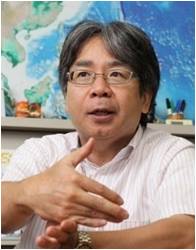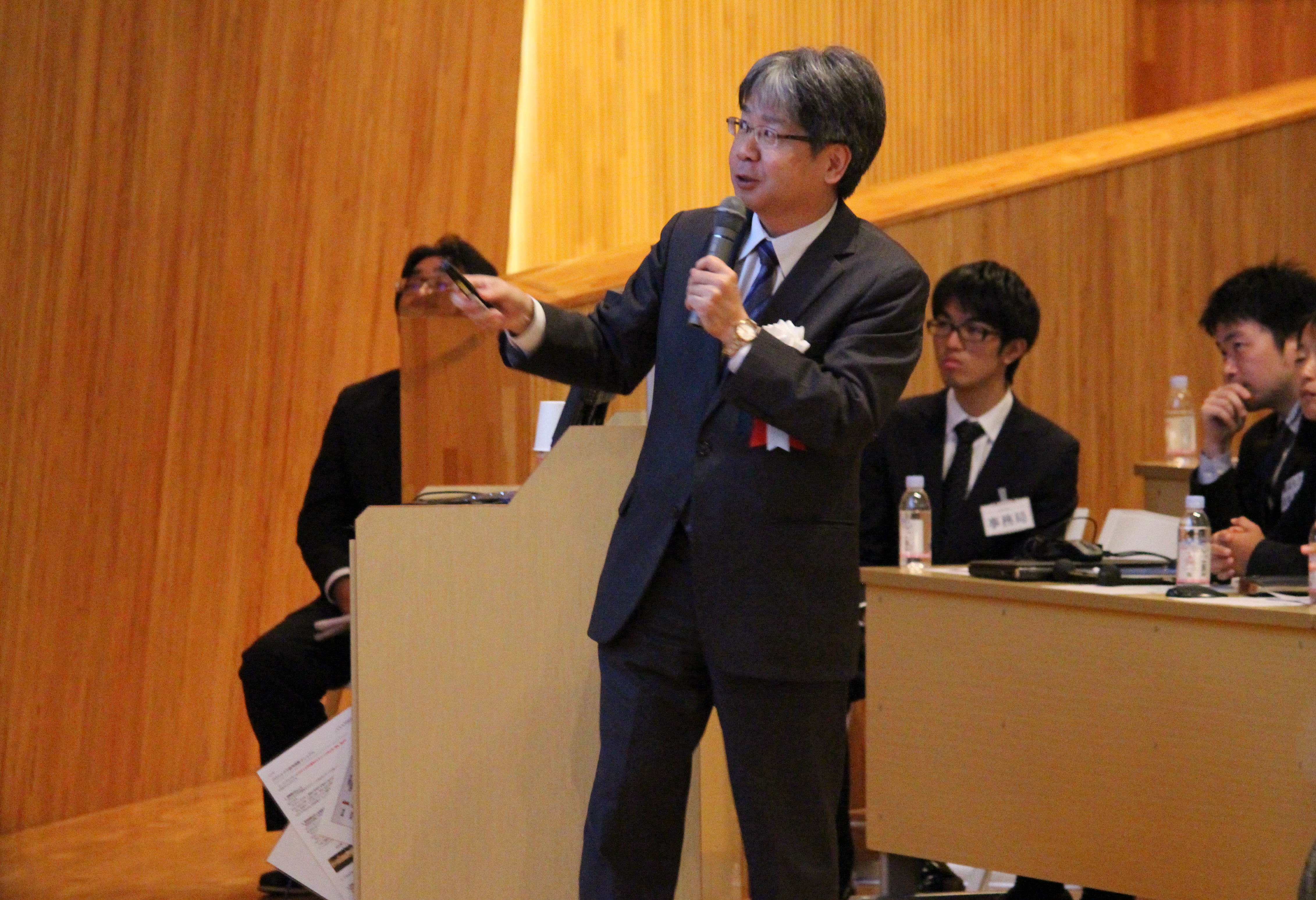1.Message from the Chairman

Today’s society where we live is supported by diverse high technologies and products. Also, Japan, which is a scientific technology-oriented nation, is in a position to lead a shift toward sustainable society in the international community, utilizing low environmental-load technologies.
A group of elements called rare earth elements is indispensable for leading-edge industries and green industries.
In 2011, our research group put forward a research result that deep-sea mud, to which no one had paid attention until then, could be a new source of rare earth elements. In the following year of 2012, we revealed that the deep-sea mud as a potential source of rare earth elements is found near Minamitorishima Island in the exclusive economic zone of Japan, indicating a possibility that Japan might be able to develop rare earth resources on its own. This is an epoch-making discovery that could eradicate the stereotype that Japan is an island country with scarce natural resources. A survey conducted by our group and Japan Agency for Marine-Earth Science and Technology in 2013 confirmed that deep-sea mud containing ultra-high concentration of rare earth elements, among the best quality in the world, lies in the sea bottom around Minamitorishima Island.
In cooperation with the government of Japan and partner companies, our group has conducted basic experiments related to concentration and smelting, economic feasibility evaluation on development projects, investigative voyages for clarifying resource distribution in more detail, and other activities. The results of the series of activities demonstrate that development of the deep-sea mud around Minamitorishima Island, a potential source of rare earth elements, is sufficiently feasible.
As discussed above, a potential is now in view that Japan might become a “nation founded on natural resources,” in just a few years from the discovery of deep-sea mud as a potential source of rare earth elements. In order to make this a reality, collaboration with industries having diverse knowledge and know-how is indispensable. The Consortium has been founded for the purpose, and intends to serve as a foundation for realizing a dream that Japan would become the first in the world to develop ocean floor mineral resources.
Yasuhiro Kato, Chairman and Professor, Frontier Research Center for Energy and Resources, School of Engineering, the University of Tokyo
2. Outline of Activities
Rare earth elements are essential for leading-edge high-tech products and low environmental load technologies. Securing of stable supplies of these elements is a critical issue for Japan. Distribution of deep-sea mud that contains these elements in a high concentration has been confirmed in sea areas around Minamitorishima Island, which is within the exclusive economic zone of Japan. Expectations have heightened on the development of these resources.
The University of Tokyo has worked to establish new development technologies for the deep-sea mud containing the rare earth elements, through collaboration between industries and academia. The efforts are intended to contribute toward stable supplies of rare earth elements and revitalize Japanese industries through the development of new demands on rare earth elements. The Rare-Earth Rich Mud Development Promoting Consortium was established in November 2014 for that purpose.
Subcommittees of the Consortium have studied technologies relating to resource quantity exploration, environmental monitoring, mud sampling and pumping from deep seas, concentration, smelting, remnant mud treatment, and other matters. Based on the results, the Consortium has studied whole optimal solutions for development systems of deep-sea mud containing rare earth elements.
3. Composition of Subcommittees
1) Subcommittee 1: Exploration, monitoring, and environment
The Subcommittee aims to establish exploration technologies in the potential areas.
[1] Exploration technologies in potential areas where high-quality mud is distributed near the ocean bottom surface
[2] Technologies for monitoring changes in the ocean floor environment while sampling deep-sea mud
2) Subcommittee 2: Sampling and pumping of deep-sea mud
The Subcommittee compares and studies technologies for gathering, sampling, and pumping deep-sea mud.
[1] Technologies for efficiently gathering and sampling deep-sea mud
[2] Pumping technologies suited to deep waters of 5,000m or more
3) Subcommittee 3: Concentration and smelting
The Subcommittee aims to verify and improve the efficiency of technologies for concentration and smelting of deep-sea mud containing rare earth elements.
[1] Technologies for concentrating rare earth elements efficiently from mud on the sea or under seawater
[2] Verifying smelting methods that utilize conventional technologies, and studying more efficient and low-cost extraction methods
4) Subcommittee 4: Mud treatment
The Subcommittee studies technologies for remnant mud treatment and recycling.
[1] Technologies for low-cost remnant mud treatment
[2] Technologies for recycling remnant mud
5) Subcommittee 5: New materials
The Subcommittee explores potential new materials using rare earth elements.
[1] Exploring new materials and new functions
[2] Studying new applications
4. Research Period
November 2014 to October 2017
5. Members
1) Researcher members
[1] Chairman
Yasuhiro Kato, Professor, Frontier Research Center for Energy and Resources, School of Engineering, the University of Tokyo
[2] University-side members
Kentaro Nakamura, Associate Professor, Department of Systems Innovation, specializing in system overview studies, School of Engineering, the University of TokyoToshihiro Maki, Associate Professor, Underwater Technology Research Center, Institute of Industrial Science, the University of Tokyo
Hiroyuki Yamamoto, Group Leader, Environmental Impact Assessment Research Group, Research and Development Center for Submarine Resources, Japan Agency for Marine-Earth Science and Technology
Shu Takagi, Professor, Department of Mechanical Engineering, specializing in mechanical energy engineering, School of Engineering, the University of Tokyo
Toyohisa Fujita, Professor, Department of Systems Innovation, specializing in system overview studies, School of Engineering, the University of Tokyo
Gjergj Dodbiba, Associate Professor, Department of Systems Innovation, specializing in system overview studies, School of Engineering, the University of Tokyo
Masaki Kitazume, Professor, Department of Civil and Environmental Engineering, School of Environment and Society, Tokyo Institute of Technology
Miki Hasegawa, Professor, Department of Chemistry and Biological Science, College of Science and Engineering, Aoyama Gakuin University
Koichiro Fujinaga, Senior Researcher, Ocean Resources Research Center for Next Generation, Chiba Institute of Technology
(also Guest Researcher, Frontier Research Center for Energy and Resources, School of Engineering, the University of Tokyo)
(also Guest Researcher, Frontier Research Center for Energy and Resources, School of Engineering, the University of Tokyo)
2) Members from partner companies, universities, and government agencies
【Partner company members】
Industrial Growth Platform, Inc.
Santoku Corporation
Mitsui O.S.K. Lines, Ltd.
Shin-Etsu Chemical Co., Ltd.
Starlite Co., Ltd.
Taiheiyo Cement Corporation
Toa Corporation
Tokyo Electric Power Company Holdings, Inc.
Toyota Motor Corporation
Nichia Corporation
JGC Corporation
Nippon Steel & Sumikin Research Institute Corporation
Japan NUS Co., Ltd.
Japan Drilling Co., Ltd.
Nippon Yusen Kabushiki Kaisha
Nemoto & Co., Ltd.
Fukada Salvage & Marine Works Co., Ltd.
Furukawa Co., Ltd.
Marine Works Japan Ltd.
MODEC Inc.
Mitsui Mining & Smelting Co., Ltd.
Sumitomo Mitsui Construction Co., Ltd.
Mitsui Engineering & Shipbuilding Co., Ltd.
【University member】
Chiba Institute of Technology
【Government agency members】
Specified Remote Island Port and Harbor Office, Kanto Regional Development Bureau, Ministry of Land, Infrastructure, Transport and Tourism
National Institute of Maritime, Port and Aviation Technology
Japan Agency for Maritime-Earth Science and Technology
3) Supporting members
Dai-ichi Heat Treatment Industry Co., Ltd.Fujinaga Construction Co., Ltd.
YBM Co., Ltd.
4) Advisors
Ginya Adachi, Professor Emeritus, Osaka UniversityTamaki Ura, Special Professor and Director of Center for Socio-Robotic Synthesis, Kyushu Institute of Technology
Shiro Inoue, Special Advisor, National Maritime Research Institute, National Institute of Maritime, Port and Aviation Technology
Yoshiyuki Shimizu, Professor, Department of Marine Resources, School of Marine Science and Technology, Tokai University
Koichi Hishida, Professor, School of Integrated Design Engineering, Graduate School of Science and Technology, Keio University
Ken Takagi, Professor, Department of Ocean Technology, Policy and Environment, Graduate School of Frontier Sciences, the University of Tokyo
5) Secretariat
Akihiko Okamoto, Yutaka Iiyama (Institute for Future Engineering) Program Officers, Division of University Corporate Relations, the University of Tokyo6. Situations of Activities
Report Meeting on Activities in the 2nd Year of the Rare-Earth Rich Mud Development Promoting Consortium
The Consortium conducts research on technologies relating to resource quantity exploration, environmental monitoring, sampling and pumping of deep-sea mud, concentration and smelting, remnant mud treatment, and other topics at respective Subcommittees, and based on the research results, studies the whole optimal solutions for development systems involving deep-sea mud containing rare earth elements.
In the Report Meeting, an outline of activities during the year was reported, and explanations were given on the future of the development of deep-sea mud containing rare earth elements that started in Japan.
- Date and time: 1:30 p.m. to 5:30 p.m., Friday, October 28, 2016
- Venue: Fukutake Learning Theater (on the 2nd basement floor), Fukutake Hall, Interfaculty Initiative in Information Studies, the University of Tokyo


Report Meeting on Activities in the 1st Year of the Rare-Earth Rich Mud Development Promoting Consortium
1) Kick-off symposium
November 7, 2014


